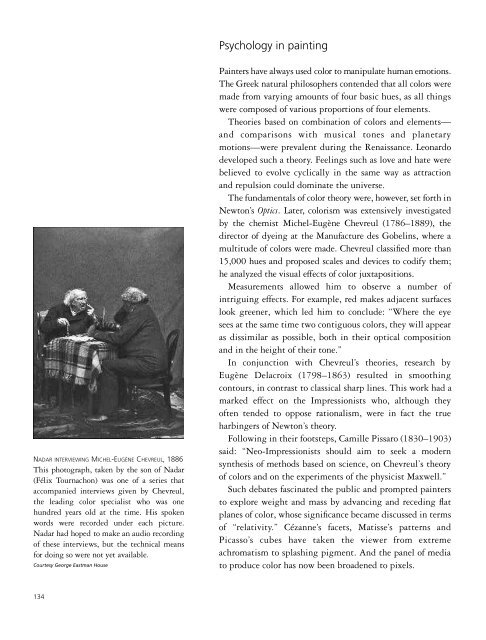Art and Science
Art and Science
Art and Science
- No tags were found...
Create successful ePaper yourself
Turn your PDF publications into a flip-book with our unique Google optimized e-Paper software.
Psychology in paintingNADAR INTERVIEWING MICHEL-EUGÈNE CHEVREUL, 1886This photograph, taken by the son of Nadar(Félix To u rnachon) was one of a series thataccompanied interviews given by Chevre u l ,the leading color specialist who was oneh u n d red years old at the time. His spokenw o rds were re c o rded under each picture .Nadar had hoped to make an audio re c o rd i n gof these interviews, but the technical meansfor doing so were not yet available.Courtesy George Eastman HousePainters have always used color to manipulate human emotions.The Greek natural philosophers contended that all colors weremade from varying amounts of four basic hues, as all thingswere composed of various proportions of four elements.Theories based on combination of colors <strong>and</strong> elements—<strong>and</strong> comparisons with musical tones <strong>and</strong> planetarymotions—were prevalent during the Renaissance. Leonardodeveloped such a theory. Feelings such as love <strong>and</strong> hate werebelieved to evolve cyclically in the same way as attraction<strong>and</strong> repulsion could dominate the universe.The fundamentals of color theory were, however, set forth inN e w t o n ’s O p t i c s. Later, colorism was extensively investigatedby the chemist Michel-Eugène Chevreul (1786–1889), thed i rector of dyeing at the Manufacture des Gobelins, where amultitude of colors were made. Chevreul classified more than15,000 hues <strong>and</strong> proposed scales <strong>and</strong> devices to codify them;he analyzed the visual effects of color juxtapositions.M e a s u rements allowed him to observe a number ofintriguing effects. For example, red makes adjacent surfaceslook greener, which led him to conclude: “Where the eyesees at the same time two contiguous colors, they will appearas dissimilar as possible, both in their optical composition<strong>and</strong> in the height of their tone.”In conjunction with Chevre u l ’s theories, re s e a rch byEugène Delacroix (1798–1863) resulted in smoothingcontours, in contrast to classical sharp lines. This work had amarked effect on the Impressionists who, although theyoften tended to oppose rationalism, were in fact the trueharbingers of Newton’s theory.Following in their footsteps, Camille Pissaro (1830–1903)said: “Neo-Impressionists should aim to seek a modernsynthesis of methods based on science, on Chevreul’s theoryof colors <strong>and</strong> on the experiments of the physicist Maxwell.”Such debates fascinated the public <strong>and</strong> prompted paintersto explore weight <strong>and</strong> mass by advancing <strong>and</strong> receding flatplanes of color, whose significance became discussed in termsof “re l a t i v i t y.” Cézanne’s facets, Matisse’s patterns <strong>and</strong>P i c a s s o ’s cubes have taken the viewer from extre m eachromatism to splashing pigment. And the panel of mediato produce color has now been broadened to pixels.134
















